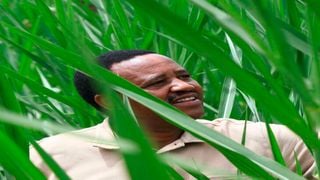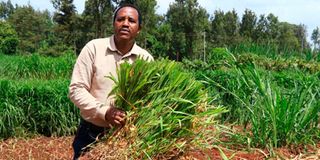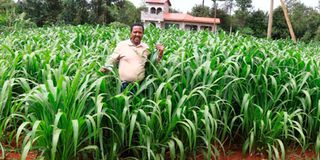
Githaiga Kihara inspects his plot of Super Napier pakchong from Thailand at Chorong'i village in Nyeri county on June 21, 2021.
| Joseph Kanyi | Nation Media GroupSeeds of Gold
Premium
Beauty of growing fodder for sale
What you need to know:
- Githaiga Kihara's two-acre leased farm hosts two varieties of napier and eight varieties of brachiaria grasses.
- Kihara, a former primary school teacher, shut his printing business in 2019 to focus on rearing 22 dairy goats.
Githaiga Kihara sits under a shade hosting three plastic chairs and a table on his farm in Chorong’i village, off the Nyeri-Kiandu-Othaya Road.
The shade is his office, he says, as he waits for walk-in customers, who visit the fodder farm to buy the feeds.
“On a good day I receive 20 customers, mainly dairy farmers, but the average is eight,” he says.
The two-acre leased farm hosts two varieties of napier and eight varieties of brachiaria grasses.
For brachiaria, he grows Basilisk, MG4, Xaraes, Cayman, Cobra, Piata and Mulato 2.
“The grasses contain an average of 18 per cent crude protein and can be substituted for concentrates to increase milk production,” he says. “However, Basilisk has up to 21 per cent crude protein. This is much higher than the normal grasses farmers feed their animals.”
The MG4 variety is preferred by farmers because it is rootier than Basilisk, he offers.
On the other hand, Cayman and Mulato 2 are not popular among farmers because they don’t grow tall; they reach knee-high.

Githaiga Kihara with splits of brachiaria MG4 grass harvested for a customer on his farm in Nyeri County.
The two varieties are also commonly attacked by red spider mites with Cayman being prone to diseases like mildew and leaf rust. For napier, he grows Giant King and Super (Pakchong 1, from Thailand) varieties.
The Giant king was developed by the Kenya Agricultural and Livestock Research Organisation and has a 14.5 per cent crude protein.
“One acre produces 180 to 200 tonnes of Super napier. The grass grows to a height of 13ft and harvesting starts after three months. An acre can feed up to 30 dairy cows.”
Kihara, a former primary school teacher, shut his printing business in 2019 to focus on rearing 22 dairy goats of German Alpine, Toggenburg and Saanen breeds that he kept then on his eighth-acre farm in Gakindu, Mukurweini.
Pushed by the need to feed his animals well, he researched on various types of fodders before approaching Kalro, which sold him his first brachiaria seeds, spending Sh5,000.
He planted the grass and saw a business opportunity in them.
“I now farm fodder on 17 acres in total, which I have leased at between Sh7,000 and 35,000 per annum in different parts of Nyeri. My farms are certified by the Kenya Plant Health Inspectorate Service (Kephis) for the production of fodder.”
To get certified, he explains, Kephis officials pays one’s farm a visit. The officials then look at the fodder species one has.
Tumbukiza method
“You have prove to them that you sourced quality planting materials. In my case I bought them from Kalro, Katumani station in Machakos County,” says Kihara who employs four workers and notes that fodder farming is stress-free as the crops are rarely attacked by pests and diseases. Again, it has less competition and demand for the grasses is rising.
According to Kihara, Super napier is good for silage while brachiaria can be used to make both hay and silage.
He plants the napier using the ‘Tumbukiza method’, which involves making a hole and filling it with water and placing in dry grass. He then mixes the topsoil with a bucket of manure then puts in hole before planting the napier cuttings.
The other types of fodder he grows are the Giant setaria grass, Panicum grass, Improved Kikuyu grass, Guatemala and the Pemba compound grasses.
On the other hand, Panicum, which is characterised by powdery blue leaves, has 14 per cent protein while Improved Kikuyu grass, which grows 35cm tall, is famed for its ability to cover the ground.
Guatemala, a favourite among his customers, contains 16 per cent crude protein and is drought resistant. It grows to a height of 8ft and is not prone to diseases.
When planting the other types of fodder, apart from Super napier, he uses the furrow method.
The grasses are planted at a spacing of 2ft by 2ft. For brachiaria, Guatemala and Giant setaria grasses, he plants splits while for Improved Kikuyu grass, he uses runners while for Super napier cuttings. He harvests all grasses using a machete or sickle.

Githaiga Kihara explains how Guatemala grass is grown on his farm in Nyeri County.
While he sells the fodder to farmers, his cash cow is production of planting materials. He sells brachiaria splits at Sh5 each, Super napier grass at Sh50 per cutting, Guatamala grass Sh20 per split, improved Kikuyu grass Sh5 per runner of about two feet, Giant setaria Sh20 per split, Giant king napier grass at Sh20 per cutting and Panicum grass at Sh10 per split.
His customers are mainly non-governmental organisations and the Kenya Climate-Smart Agriculture Project (KCSAP) members from across the country.
For those far, he takes their orders, processes and sends the planting materials via courier. He also markets his products on social media page Brachiaria and Moo Fodder Supermarkets.
Dr Donald Njarui, a principal scientist at Kalro, says fodder grasses, like other plants, are also prone to pests and diseases.
He notes hybrid grass varieties flourish best in areas that experience 300 millimetres of rainfall and above.
“Farmers in the eastern and northern regions with less rainfall should grow fodders like Rhodes grasses.”
He adds that farmers should intercrop different varieties of pastures with legumes as the latter fix nitrogen in the soil which supplement nutrients for the fodders.
He cautions against spraying animal fodder with chemicals, noting they should be grown organically.





